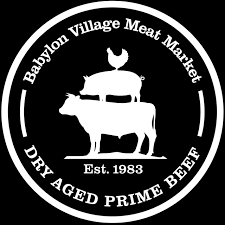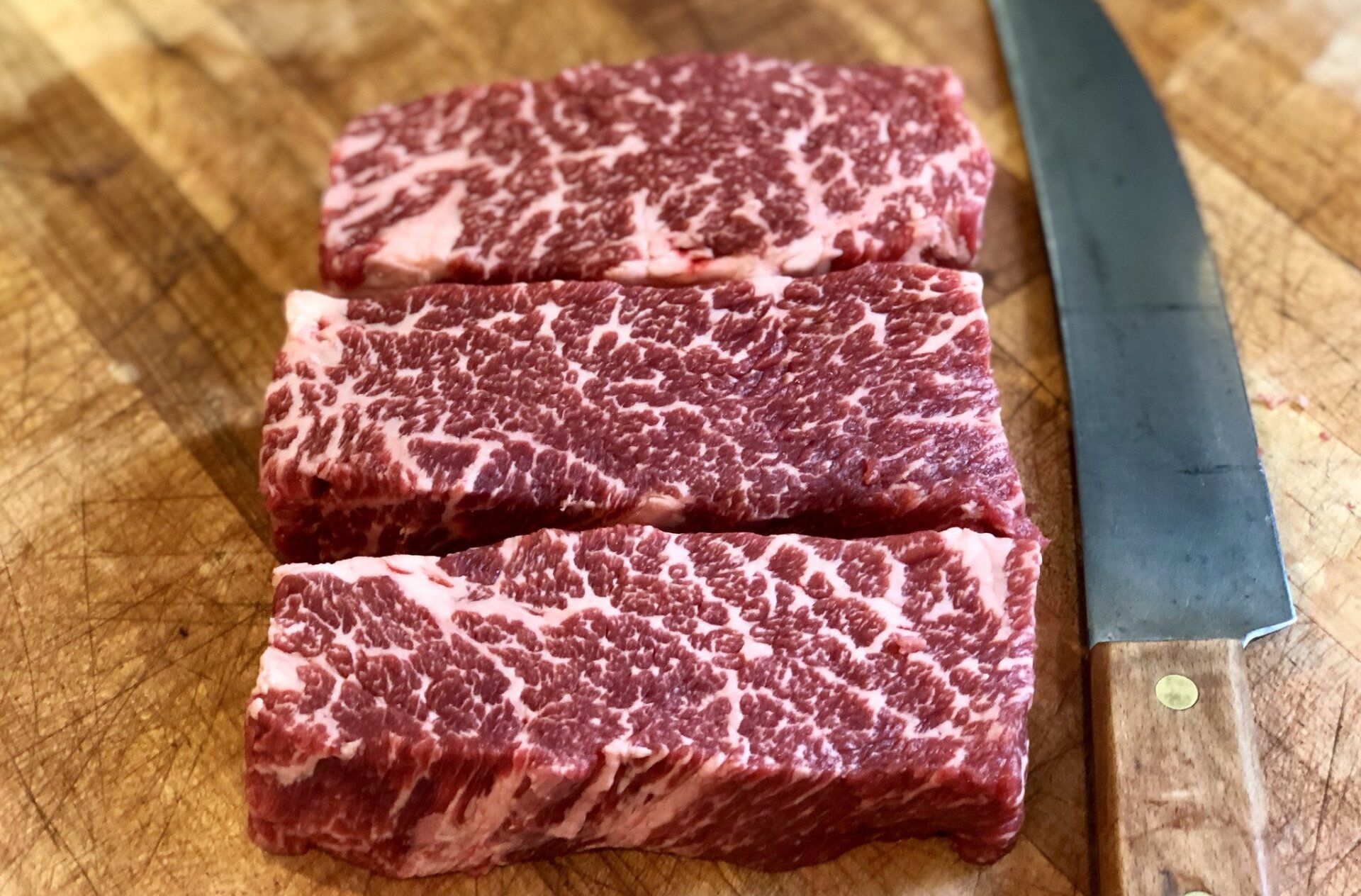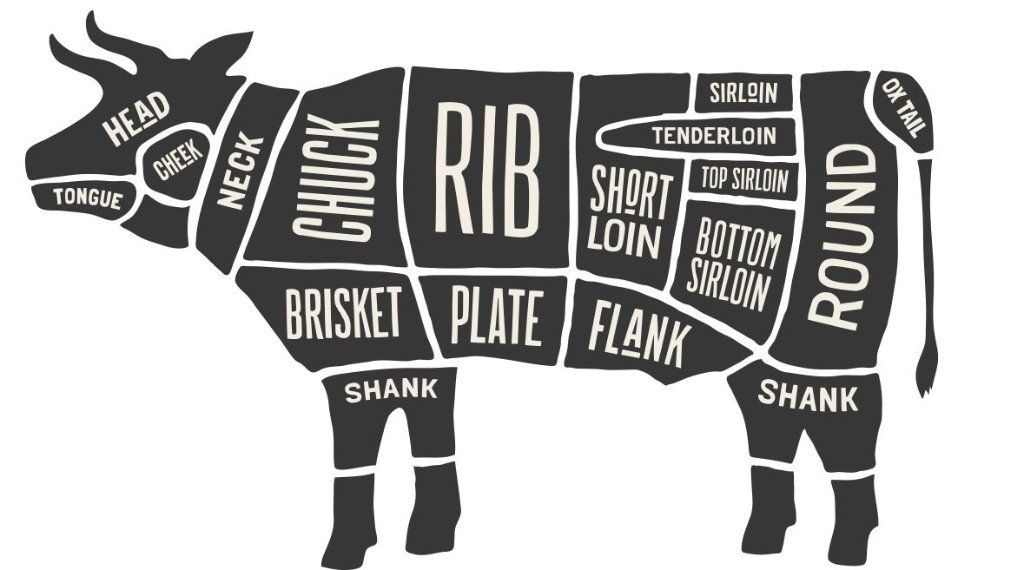We use the strongest encryption available,
so all your transactions are 100% secure.
Custom Cuts
SELECT CUTS
Your Choice
Steak
- Chuck
Chuck meat comes from the cow’s shoulder. A cow’s shoulder is used a lot, so it can be a tough cut of beef. However, it’s also a very flavorful cut, and butchers cut it in a variety of ways so you have lots of options at the grocery store. Types of cuts you’ll see for chuck are ground chuck (hamburger), flat-iron steak, chuck short ribs, shoulder tender medallions, chuck pot roast, blade roast, boneless chuck short ribs, stew meat, country style ribs, and top blade steak, just to name a few. You should choose chuck beef when you want lots of flavor, but need to be cost conscious too.
- Brisket
The brisket is the steer’s breast. Brisket is usually tough and contains a substantial amount of fat. But don’t let that fool you! Chefs know that if you tenderize it with a marinade or rub, and cook it low and slow, it’ll melt in your mouth. Brisket is primarily used for barbecue, corned beef or pastrami. Cook a brisket when you want to cook low and slow.
- Shank
The shank is located at the animal’s forearm in front of the brisket. It is one of the toughest cut. One of the most famous dishes that comes from the shank is Osso Buco, which requires braising to make the meat more tender. The shank is often used for stews and soups, because it’s tough.
- Ribs
Ribs are made up of the cow’s ribs and backbone. There are 13 pairs of ribs, but only the last section (6-12) are in the primal section of the ribs. The others are in the chuck cut. Ribs have lots of flavor and marbling. Types of cuts you’ll see for ribs are Delmonico steak, boneless ribeye roast, cowboy steak, ribeye steaks and beef short ribs. Choose ribs when you want a tender cut of beef with extra marbling.
- Plate
The plate, or short plate, is the other source of short ribs. It’s found near the abdomen, and it’s fattier. Beef from the short plate are often used for fajitas, pastrami, skirt steak, Philadelphia steak and short ribs.
- Loin
The loin is where the most expensive cuts of beef come from. The loin is located at the top of the steer directly behind the rib, and since it’s not a heavily used muscle, it’s very tender. The loin has two parts: shortloin and sirloin. Popular cuts from the shortloin are filet mignon, tenderloin steak, T-bone, Porterhouse steaks, strip steak, New York Strip, and KC Strip.
Earlier we talked about how one cut of beef often has several different names. The shortloin is a great example of this. A T-Bone and Porterhouse are from the shortloin. They’re the same steak. The only small difference is a Porterhouse is a larger version of the T-Bone. Then, when you cut the beef out around the “T” bone, you get two unique cuts – a filet and a strip steak. A strip steak has lots of difference names too like New York Strip, Kansas City Strip, and hotel steak, just to name a few. The sirloin area is a little less tender than the shortloin, but it’s also more flavorful. Common cuts from the sirloin area are sirloin steak, center cut sirloin steak, top sirloin, bottom sirloin, ball tip steak, Tri-Tip Roast and Tri-Tip Steak. Cook a cut from the loin when you’re hungry for a flavorful and tender cut of beef.
- Round
The round is a lean and inexpensive cut. It’s found at the cow’s rump and hind legs, so it’s sometimes tough. When you’re at the grocery store, you’ll often see round sold as ground beef. Other common cuts are round steak, eye of round, tip steak, tip roast, top round and bottom round roasts.
- Flank
The flank is located below the loin. It has no bones, and is very flavorful but also very tough. It used to be less expensive at the grocery store, but this has started to change. Why? Flank steaks are known for being lean. Since consumers want lean meat more than ever before, it’s increased flank steak’s popularity and price. Popular flank cuts are flank steak and London broil.
Pork
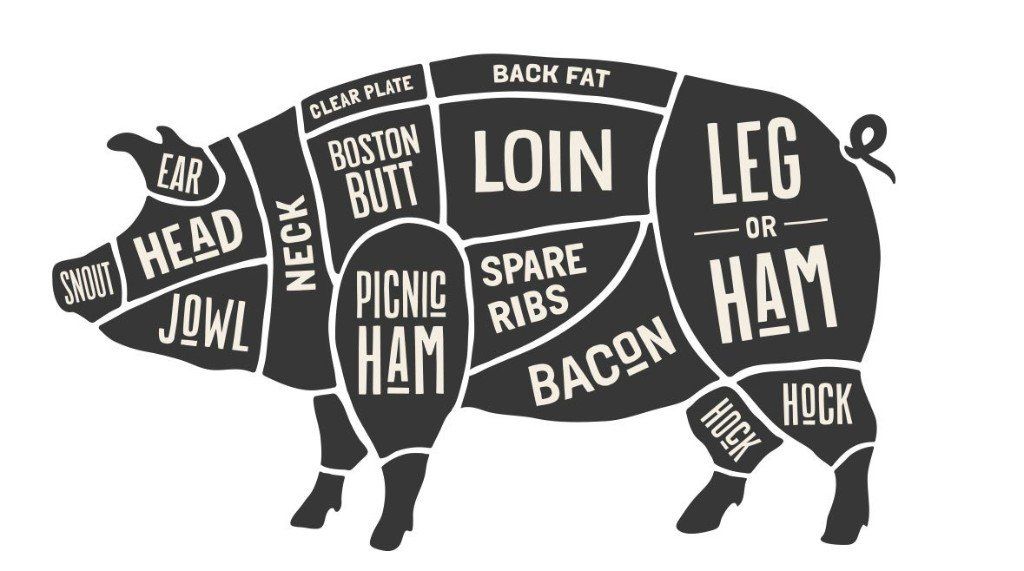
- Belly (Bacon, Pancetta, Pork Belly)
If bacon, pork belly, and pancetta all seem similar to you, it’s because they are. These fatty cuts of meat come from the side or belly area of the pig, and are particularly high in fat content. Unlike bacon, which is cured, smoked, and generally served in a slab or slice, pancetta (thought of as the Italian form of bacon), is cured with salt and spices but not smoked, and generally sold rolled into a circular shape or pre-chopped into small cubes. Pork belly (which has grown hugely in popularity in recent years) is bacon that has not been cured, smoked, or sliced. Instead, it’s often braised or seared in small pieces.
- Spareribs
As the name might suggest, spareribs come from the lower ribs of the pig where they meet the breastbone. With their high fat content, spareribs are a deliciously decadent part of the pig, and most often served barbecued so the rendered fat drips away.
- Jowl (Guanciale)
Pork jowl (or cheek) is an unsurprisingly fatty part of the animal. Guanciale, which takes its name from “guancia,” meaning “cheek,” is the most commonly available pork cheek product. The jowl is cured for a month in a combination of salt, pepper, chili powder, and occasionally sugar, then hung and aged for an additional month before being sold. Guanciale is often used in place of pancetta or bacon, as it can be similarly rendered down and produces a significant amount of fat.
- Pork Shoulder (Boston Butt)
Totally misleading, pork butt is quite far from the rear end of the pig and in fact, it’s the shoulder connected to the upper front leg. The rectangular roast at the top of the leg is known as the “butt,” or “Boston butt,” as butchers in Boston allegedly had a specific technique for cutting this part of the animal. The “picnic” or “picnic shoulder,” which comes from the lower part of the shoulder, has a more triangular shape. It’s used for pulled pork or, when cured, for ham. Pork butt is a combination of both lean meat and fat, and is generally pretty large—up to 18 pounds or more. Pork shoulder is frequently braised for long periods of time and it’s eaten in many cultures, from the Korean Bo Ssam to Southern Pulled Pork to Latin American Puerco Asado.
- Leg (Ham)
While pork leg can often be roasted or braised whole, the leg is most often used to make ham—one of the most popular pork preparations. When uncured, it’s often called fresh ham, and can be available bone-in or boneless. Pork leg is a popular ingredient in a myriad of cuisines, from Cuban to European, but it is most often cured and served sliced into individual pieces.
- Hock
The ham hock comes from the bottom part of the pig’s hind leg: it’s rarely eaten whole. It combines bone, meat, fat, gristle, and connective tissue. It’s usually smoked and/or cured before being sold. Ham hock is most frequently used to flavor dishes, particularly soups and stews.
- Loin (Tenderloin, Sirloin, Chop & Center Loin)
The loin, which includes many of the most popular cuts of pork, comes from the region between the shoulder and the leg, on both sides of the backbone. The loin can be cut into tenderloin, pork chop, center loin, and more. It features less fatty but still very tender meat, and is covered by a fatty layer known as “fat back.” Rib chops, loin chops, sirloins, and many of the most popular (and most expensive!) cuts of pork come from this region.
Chicken

- Breast
Arguably the most popular part of a chicken, you can buy breast either whole or pre-sliced, and with the the skin either on or off. It’s the leanest cut of the bird and, without the skin, becomes leaner still. Chicken breast can be pan-fried, stuffed, baked, roasted or barbecued. Smaller pieces can be added to stews, stir-fries and pies – just beware of overcooking, as this can make it quite dry.
- Wings
The cheapest cut of the bird, chicken wings, are absolutely fantastic to eat! They come on the bone and when roasted, grilled or barbecued, their skin becomes crispy and delicious. They’re higher in fat than breast meat, with a similar fat content to thighs and drumsticks. Bring out the richer, meaty flavours of the wings by coating in a sweet, sticky glaze. Marinate these little beauties overnight for the most flavoursome results the next day. The top, meatier half of a wing can be used separately and is called a ‘drumette’.
- Drumsticks
Drumsticks are the chicken’s shins. Like wings, they come on the bone and are cheap and easy to cook. They’re also a big barbecue favourite and work well in curries.
- Thighs
Arguably the tastiest part of the chicken, thighs are little parcels of tender, juicy meat from the top of the bird’s leg. You can buy them bone in, or bone out, and with the skin on or off. The meat is darker and firmer than the white breast meat and needs slightly longer to cook. The firmer texture means they hold together brilliantly. The best way to cook skin-on thighs is to roast them, then finish off under a grill to crisp up the tops.
- Legs
Instead of dividing the legs into drumsticks and thighs, try leaving them whole, then roasting them in the oven or grilling them on the barbecue. They look great served whole on a platter with hearty, punchy flavours. Cooked on the bone in a rich and fragrant stew, the chicken leg becomes a thing of real joy.
- Whole Chicken
Whether you roast the bird whole, or break it down into the different cuts yourself, buying an entire chicken is often the most economical way to enjoy the meat. Poaching chicken is a wonderful way to retain all the flavours of the bird, or roast it simply with a lemon and some herbs in the cavity.
If you break down the bird into the separate cuts, make sure you retain the carcass and use it for incredible homemade stock.
When it comes to barbecuing the bird, sit the chicken upright for a super-juicy beer butt chicken, or flatten it out as a spatchcock and cover in marinade in order to cook it more quickly on the grill.
Lamb
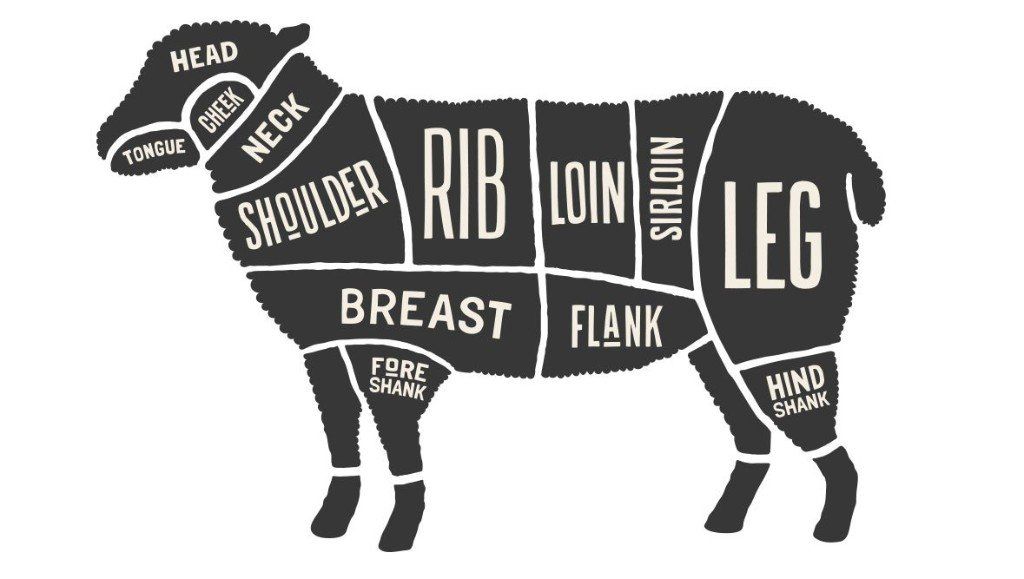
- Shoulder
This part of the animal works hard, so the meat from a lamb’s shoulder is full of flavour. It takes a while to become tender, but this means it’s a great choice for stewing and slow-roasting. To maximise the flavour, cook lamb shoulder on the bone so the meat simply falls apart when pulled with a fork. Recipes using lamb shoulder are fail-safe crowd pleasers. Perfect for Sunday dinner.
- Chop/Rack
Lamb chops or cutlets are the most expensive cuts of lamb, but are incredibly delicious and tender. They are taken from the ribs of the lamb and cooked individually, normally over a grill or a barbecue. When a number of them are left together and cooked as a whole, they’re called a rack of lamb. Chops and racks can be French trimmed, where the meat is scraped from the ends of the rib bones, which looks super-impressive on a plate. Best served pink, they are amazing roasted and served with crushed potatoes or served lollipop style – perfect for sharing.
- Loin Chop
These are mini T-bone steaks cut from the waist of the lamb. On one side of the chop is the lamb loin and on the other side is the fillet. Just like chops, they’re great for grilling or barbecuing.
A few loin chops kept together in one piece, then boned and rolled, make a great roasting.
- Rump
The rump comes from the back of the lamb. This cut is lean, tender and full of flavour – just be careful not to overcook as it will become tough if left to dry out. It is delicious pan-fried whole, finished in the oven for a few minutes, then sliced to reveal its pink center. Or, it can be cut into chops on the bone then grilled or pan-fried.
- Leg
Like the shoulders, the legs of a lamb work hard, which means that this cut has a good, strong flavour. Leg of lamb is great roasted whole on the bone, or boned and barbecued. It’s a fairly lean muscle, so take care not to overcook it, or else it could end up quite dry. Rub it all over with a herb oil, some garlic and even a little mustard, if you like, roast in the oven, then finish off on the barbecue to get a great gnarly smoked flavour. This is a great one for a weekend spent with family, or when entertaining a big group.
- Shank
Lamb shank is a super-simple, cheaper cut that goes a long way. Taken from the lower part of the back legs, there is a lot of collagen in the shank, which, when cooked slowly, gives the meat a lovely soft, melting texture, making this another cut that’s perfect for stews and slow-cooking.
- Neck
Neck is a cheap cut and available at supermarkets and butchers. It is left connected to the shoulder, but a good butcher should be willing to separate it out for you. Lamb neck can be cooked slowly on a low heat, yet unlike the shoulder, it can also be treated like a steak and cooked quickly over a high heat until pink. It goes well with a whole load of flavours and is delicious served with a great mash when cooked low and slow. It works really well as a stew or curry and is a great cut of meat to make kebabs with, too.
Catered Affairs
85 Deer Park Ave
Babylon Village, NY
*Discounts are automatically calculated and offered based on purchase history.
- Monday
- Closed
- Tue - Sat
- -
- Sunday
- -
All Rights Reserved | Made with ♥ by Craic.in
